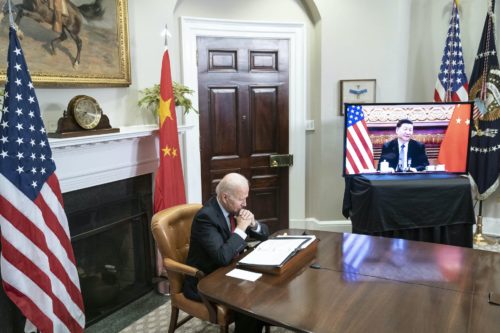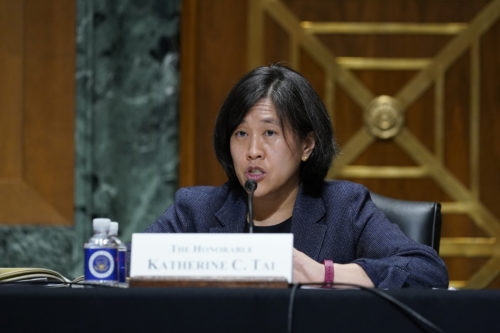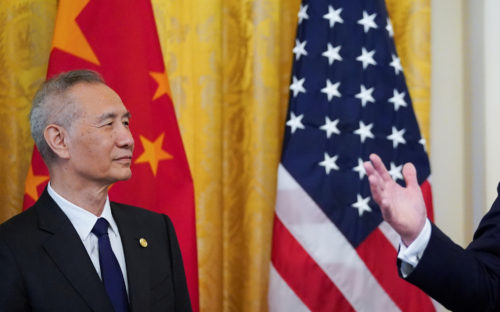China vs. the U.S. Treasury: Why Beijing won’t use the ‘nuclear option’ of selling American debt
Why China won’t sell its U.S. debt holdings, even with the trade war in its second year. Plus, the related issue of Chinese currency devaluation.
At the present, China is America’s largest foreign creditor, holding $1.1 trillion in U.S. Treasury bonds. That accounts for 4–5 percent of America’s national debt, which is now a staggering $22.22 trillion. America’s addiction to debt and China’s willingness to buy it is nothing new, but the continual escalations of the U.S.-China trade war have revived worries that China will “weaponize” its U.S. Treasury holdings with a large-scale dump into the open markets.
Described here, the economic mechanisms of a U.S. Treasury holdings sell-off are fairly straightforward: If China’s holdings were sold into the open market, it would create a seismic shift in the supply and demand for U.S. bonds. Consequently, the price for bonds would fall and their yields would surge. Because Treasury bond yield rates are benchmarks for interest rates on borrowing throughout the country, the sudden, unexpected spike in interest rates would roil the U.S. economy, derail growth, weaken the U.S. dollar, and cause global panic in holdings of U.S. debt and dollars.
Essentially, this is what’s been referred to as China’s “nuclear option.” Admittedly, it makes for a good headline. But most analysts dismiss the possibility out of hand.
As former Treasury official Brad Setser wrote last year when the U.S.-China trade war started to kick off: “On the surface, it looks like the U.S. is extraordinarily vulnerable,” Setser said. But upon further examination, “there are no shortage of technical options to limit the impact of China’s sales.”
Arthur Kroeber, co-founder and head of research at Gavekal Dragonomics, said that a sudden sell-off “would only make Beijing look reckless and foolish — the last thing Xi would want as China seeks to play the ‘good guy’ in contrast to the unpredictable Trump.”
After the trade war ratched up a few more notches, the economists at Trivium made a “public service announcement” in their October 2018 Tip Sheet to say there are plenty of reasons China wouldn’t sell its holdings, the top three being, in their words:
- “It would be ineffective — the Fed could buy up the treasuries that China sold.
- China would be giving up a huge safety net — the point of the FX reserves (i.e., U.S. treasury holdings) is to have them in case of emergency.
- It would send the CNY soaring — the move would inflict massive pain on China by tightening financial conditions dramatically.”
The third point is key. The fact is that China’s U.S. Treasury holdings are key to managing China’s strictly controlled currency, the yuan, which has typically been kept undervalued — but stable — and allowed China to become an export powerhouse over the last several decades.
Michael Pettis describes the dynamic cogently:
The real reason China cannot sell off its holdings of U.S. government bonds is because Chinese purchases were not made to accommodate U.S. needs. China made these purchases to accommodate a domestic demand deficiency in China: Chinese capital exports are simply the flip side of the country’s current account surplus, and without the former, they could not hold down the currency enough to permit the latter.
So, the best way to look at China’s U.S. Treasury holdings is not as an economic weapon but instead as a monetary tool for keeping its currency stable and exports continually flowing.
But speculation has still not ceased that China could try to inflict pain on the U.S. economy through sales of American debt. As recently as May 2019, Hú Xījìn 胡锡进, editor of the nationalistic tabloid Global Times, claimed that “many Chinese scholars are discussing the possibility of dumping US Treasuries and how to do it specifically.”
Concerns about China’s currency
Currency devaluation is another often-rumored extreme measure that China could take to retaliate in the trade war. In theory, it would make Chinese products artificially cheaper for overseas customers, and counteract the effects of tariffs — taxes on imports — so those customers would keep buying.
Some economists, such as Brad Setser (mentioned above), believe that this is still “the logical ‘asymmetric’ Chinese response to a trade war,” but China has not implemented it thus far. Since the trade war began, China has actually been seen to prop its currency up, and prevent it from depreciating too fast. A large reason for this is political: If the Chinese yuan weakened past the psychologically important seven-to-the-dollar threshold, the U.S. Treasury would very likely formally accuse China of currency manipulation, something it has repeatedly declined to do, despite Trump’s campaign promises.
How do China’s U.S. Treasury holdings figure into trade?
The best way to understand more about the current dynamics of China’s holdings of U.S. debt and the yuan exchange rate is to take a step back in history. Here’s a quick timeline:
At the beginning of reform and opening in 1978, when China first began shifting to a post-Mao, export-led economic growth model, its foreign exchange rate was both heavily controlled and massively overvalued at 1.5 yuan per dollar. This let China import capital goods and raw materials cheaply, but it created a huge barrier to developing its export industries. So from 1979 on, Chinese authorities gradually devalued the yuan, letting it weaken to 8.7 yuan per dollar in 1994, which was successful in laying the groundwork for China’s export boom in the following years.
Responding to the needs of foreign businesses and investors, who wanted the yuan to stay low but at a stable and sustainable market value, China changed the way it managed its currency. After allowing the yuan to float toward an international market value for the next couple of years, Chinese authorities fixed the exchange rate, 8.3 yuan per dollar, in perpetuity. The government kept the yuan pegged to the dollar despite pressure to devalue the yuan during the 1997 Asian Financial Crisis, when other exporter nations of Asia were engaging in competitive devaluations with each other. But whatever China lost in short-term exports was made up for by earning a reputation as a stable environment for investment, contributing to double-digit growth in its export sector into the 2000s.
But while China could manage its own exchange rates, since it was pegged to the dollar, any volatility in America’s currency would impact China. And this was true even after 2005, when China made the decision to no longer peg the yuan to the U.S. dollar, opting for a managed floating exchange rate in which the yuan was allowed to rise or fall by 0.3 percent (later 0.5 percent) against the dollar from a rate set by the People’s Bank of China (PBoC) every morning.
And this is where China’s foreign exchange (FX) reserves come in: Starting in the 1990s and throughout the 2000s, China accumulated a massive stockpile of foreign exchange reserves in the People’s Bank of China that made for massive investment potential. And U.S. bonds, backed by the almighty dollar and offering a tidy return on investment through interest paid, was the best destination for China’s FX reserves. But more importantly, dollars flowing into U.S. Treasury bonds had the effect of keeping demand high, interest rates low, and the dollar strong — thus, a comparatively weaker yuan.

Graph courtesy of the Council on Foreign Relations.
This leads people to assume the effect could be reversed. If China were to dump its U.S. Treasury holdings, this would lead to a surge in interest rates in order to encourage other buyers to make up the difference, making everything from car loans to mortgages more expensive throughout the U.S. economy. But the reality of such a thing happening — and indeed, as recent precedent has shown — is very different.
Case in point: The 2015–16 financial crisis
By 2014, the yuan had appreciated to six yuan per dollar, and China’s FX reserves had reached their highest point at $3.95 trillion, leading Premier Lǐ Kèqiáng 李克强 to remark in May that “foreign exchange reserves have become a big burden for us,” and that China would take steps to reduce its trade surpluses with other countries. But sustained declines in China’s trade into the following year led Chinese authorities to devalue the yuan, widely interpreted as a move to prop up Chinese exports, but caused panic and capital flight as investors sold off the yuan.
In response, the PBoC turned to its reserves and U.S. Treasury holdings to control the ever-weakening yuan, as investors began to sell it off, getting rid of $120–$130 billion worth of U.S. Treasury holdings for dollars in the first month of trouble in 2015. But continued stock market turbulence throughout the same period in 2015 and 2016 compounded negative sentiment toward the strength of China’s economy. China doubled down, burning through its reserves and U.S. Treasury holdings in order to prevent the yuan from collapsing, in what became the sharpest decline on record (as shown in the figure below).
Graph courtesy of Bloomberg.
But U.S. bond markets never caught any of this turbulence, and demand for U.S. Treasury bonds remained strong. This is because these massive sell-offs never signaled any underlying problems with the U.S. economy, and market sentiment didn’t lose confidence in either the dollar or the strength of the U.S. economy. If China were to do this again in the trade war, it would be similarly ineffective.
But it’s also clear, as Chinese leaders manage the shift away from the past model of export-led growth, make moves to open up financially, and push for greater global adoption of the yuan, China’s holdings of U.S. Treasury bonds will likely lessen over time (which seems to have taken place over the course of the trade war) as their role in monetary policy diminishes over time.
Further reading:
- China’s Economy: What Everyone Needs to Know / Amazon
Arthur Kroeber’s book. For this topic, we especially recommend the chapter on China’s financial system. Also listen to a Sinica Podcast with Kroeber: Arthur Kroeber vs. The Conventional Wisdom. - Is the renminbi undervalued or overvalued? / CSIS ChinaPower Project
An interactive piece published in 2016 and updated through 2018 that explains the dynamics of Chinese currency levels. - What would happen if China started selling off its Treasury portfolio? / Council on Foreign Relations
Brad Setser’s blog post from June 21, 2018. - China cannot weaponize its U.S. Treasury bonds / Carnegie Endowment for International Peace
An analysis by Michael Pettis in May 2019. - Explainer: Will China dump U.S. bonds as a trade weapon? Not so fast / Reuters






